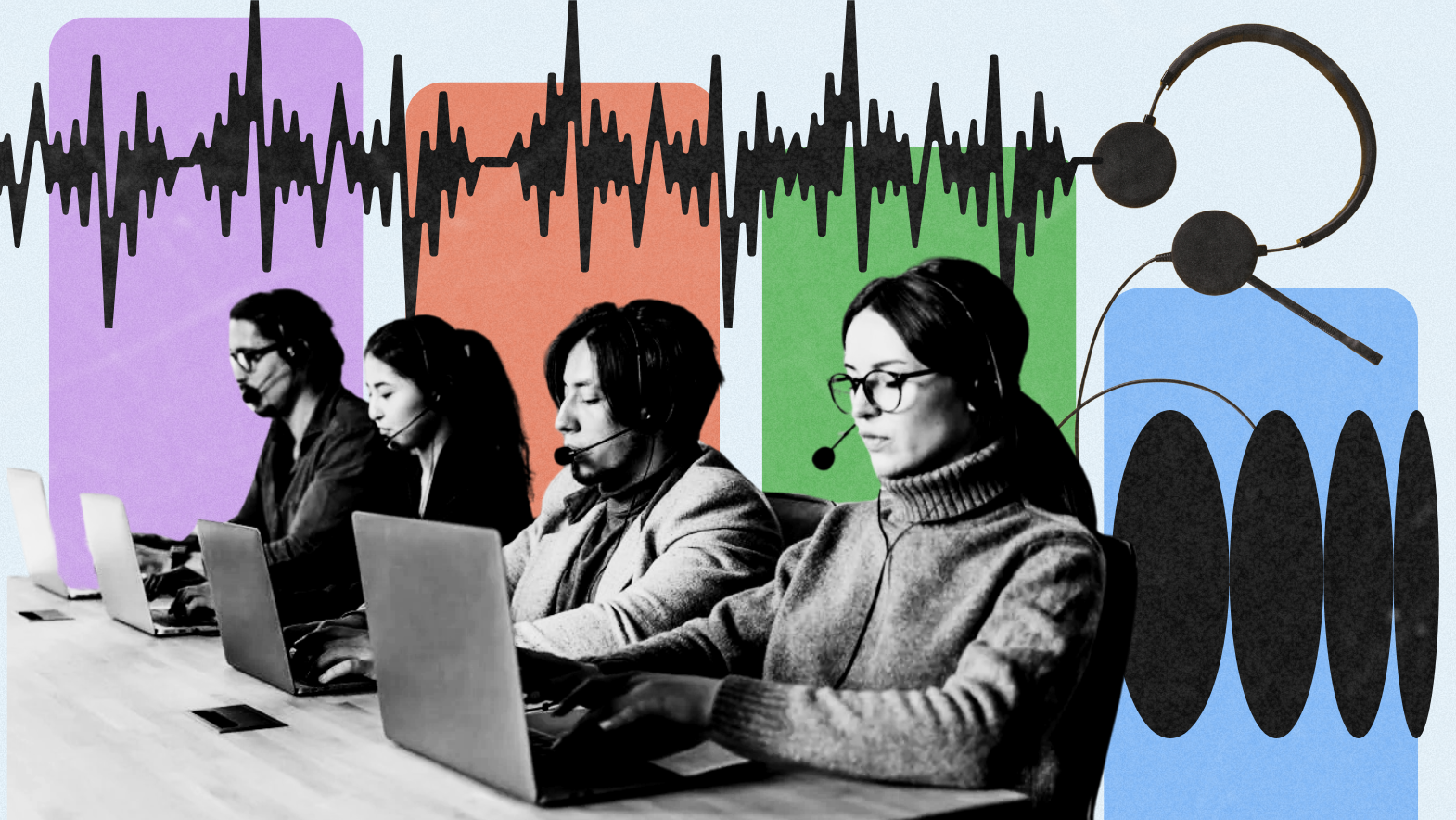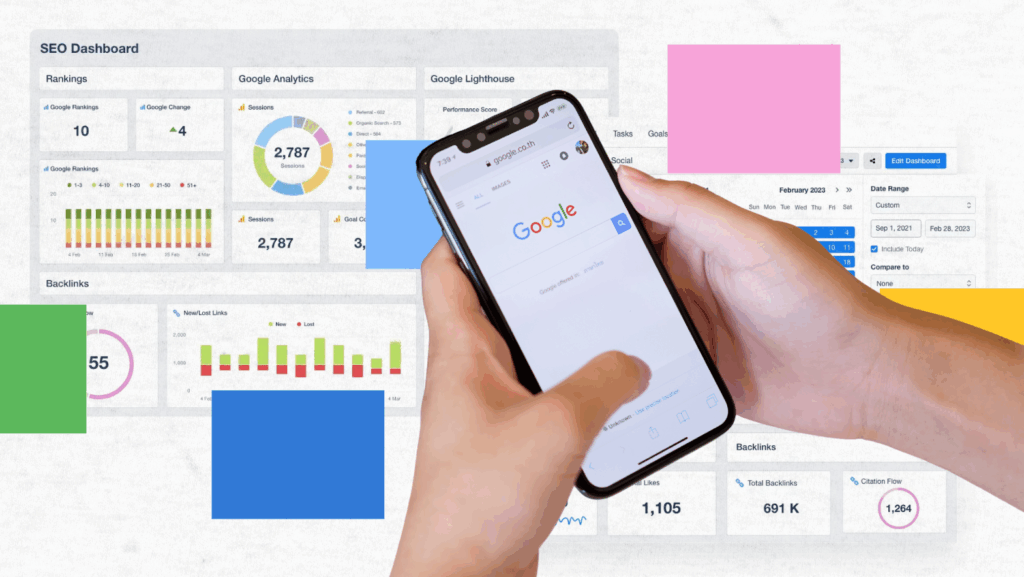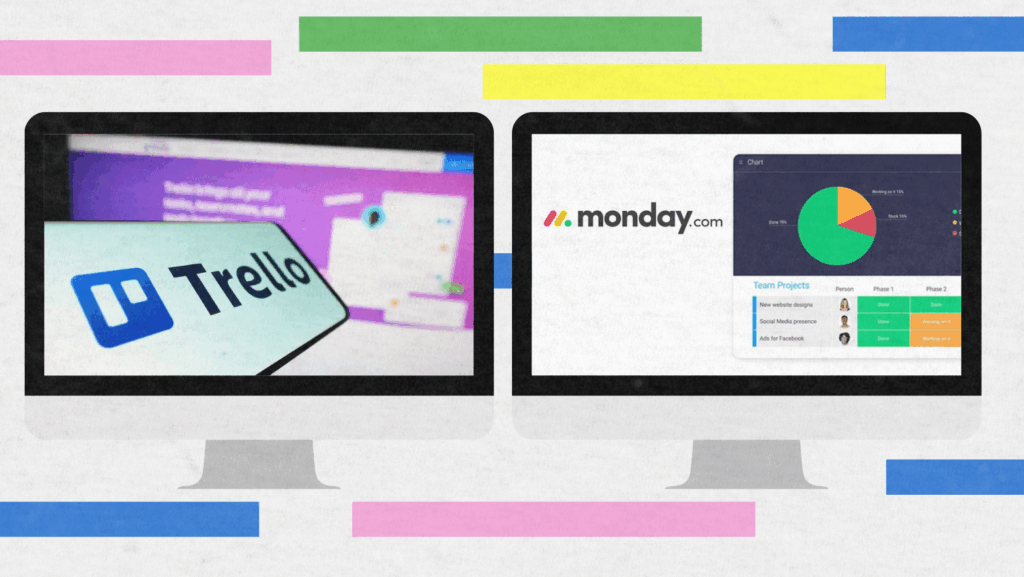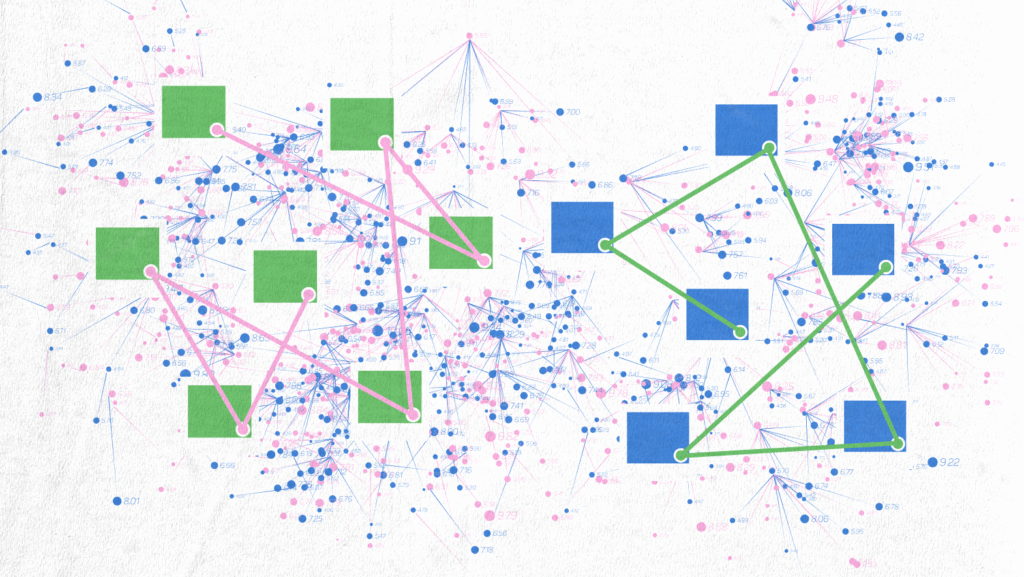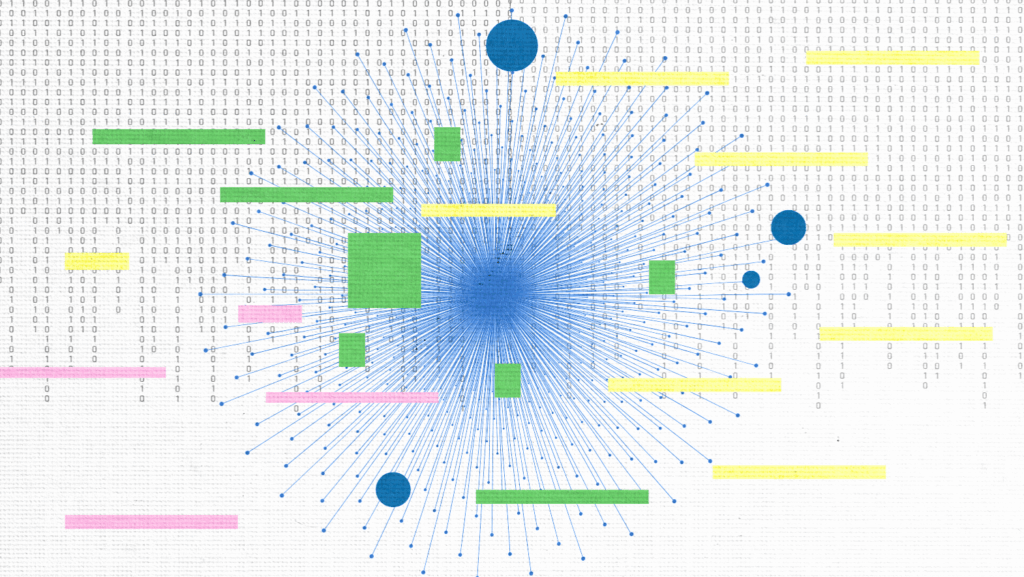Let’s talk about something that might be quietly draining your call center’s performance without you even realizing it: call abandonment.
You know the drill – your customer dials in, sits through a few rings (maybe even a hold tune), waits… and then hangs up before speaking to anyone. That, my friend, is what we call an abandoned call. And when this keeps happening? What you’ve got is a high call abandonment rate – a sneaky KPI that’s out to ruin your customer satisfaction, revenue, and team efficiency all at once.
Now, here’s the thing: even a small bump in your call abandonment rate – we’re talking a jump from 25% to 54% – can create ripple effects throughout your operations. We’re not just talking about missed phone calls. We’re talking about missed opportunities, frustrated customers, and wasted resources.
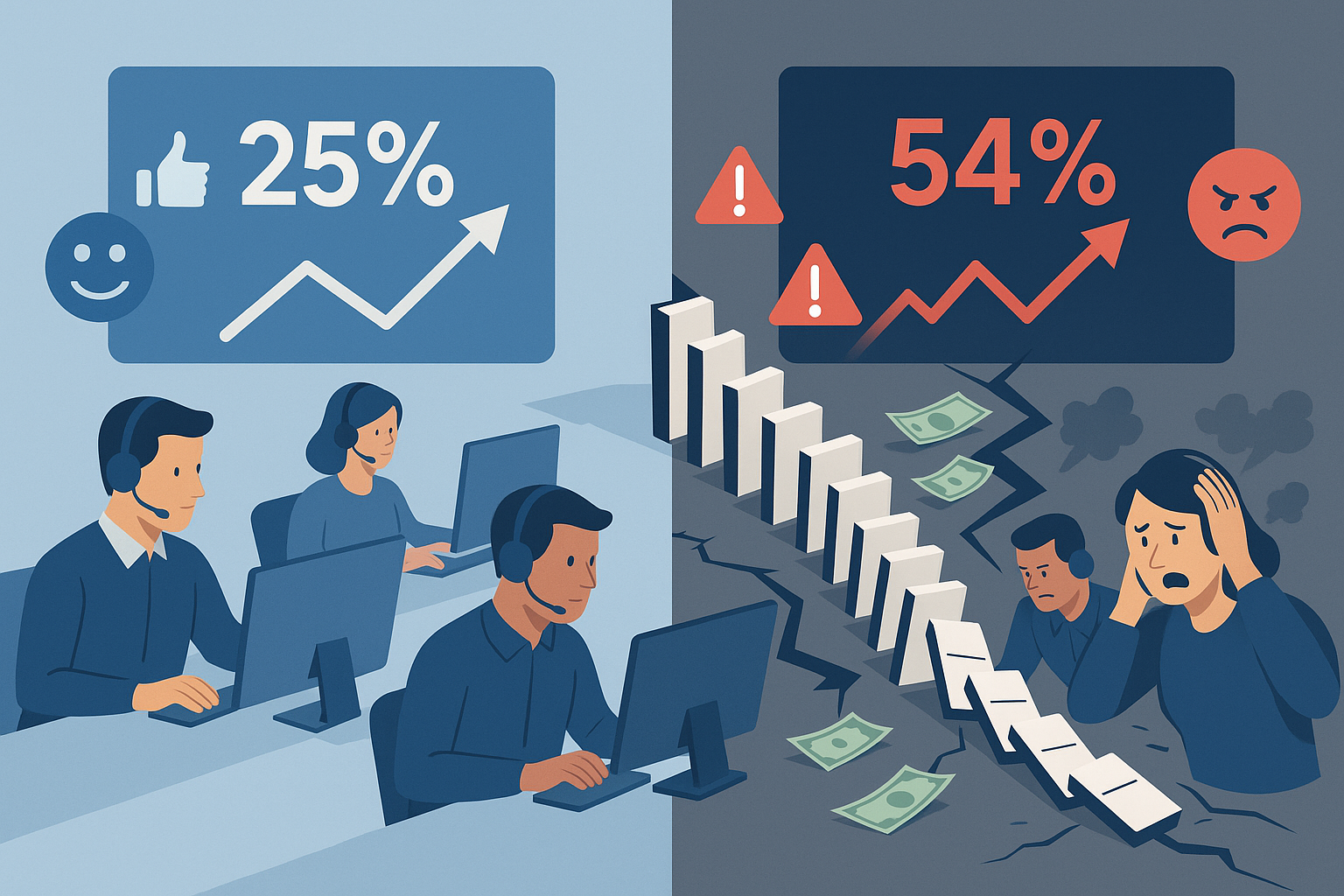
But here’s the good news: it doesn’t have to stay this way.
In this post, we’re going to break down exactly why your call center abandonment rate matters, how it impacts your business, and – most importantly – how you can fix it. Whether you’re dealing with abandoned calls on a daily basis or just trying to sharpen your call center performance, we’ve got practical tips you can run with.
What Is Call Abandonment Rate?
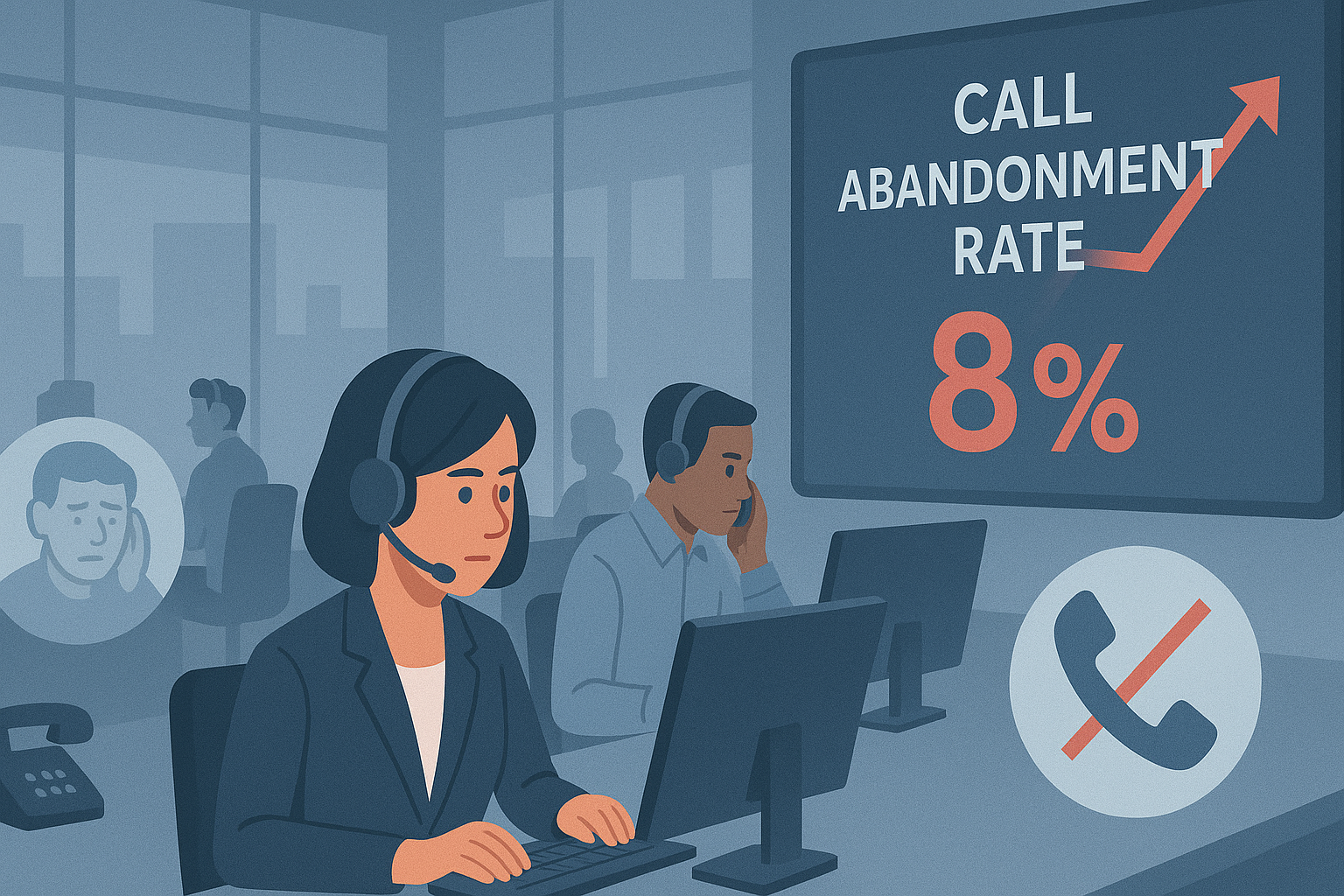
Let’s start with the basics. Your call abandonment rate is the percentage of outbound and inbound calls where the caller hangs up before reaching a live agent. It’s one of those KPIs that quietly influences everything from customer feedback to revenue, making it a must-watch metric for any contact center.
Now, let’s clear up some common mix-ups around abandoned calls. These differences might seem small, but they matter a lot when it comes to improving your call center operations.
Abandoned vs. Dropped Calls
Customers may leave the call for different reasons, but not all exits are in your control. Here’s how abandonment and dropped calls differ:
| Abandoned Calls | Dropped Calls |
| The caller hangs up voluntarily | Call ends due to a technical issue |
| Often caused by long hold times or frustration | Usually linked to signal issues or system failures |
| Can be reduced with better queue management | May require IT or telecom support to resolve |
Abandoned vs. Missed Calls
These two get mixed up all the time, but they happen at completely different points in the process. Here’s the breakdown:
| Abandoned Calls | Missed Calls |
| The caller connects but hangs up before the agent answers | The call never reaches an agent at all |
| Logged in the system, but unresolved | Often due to agent unavailability or routing issues |
| Indicates long wait or poor experience | Indicates staffing or routing breakdown |
IVR Hang-Ups vs. Queue Drop-Offs
Not all hang-ups are equal, even within abandonment. Where a caller drops off tells you a lot about what needs fixing.
| IVR Hang-Ups | Queue Drop-Offs |
| Caller exits during automated menu (e.g., “press 1 for X”) | The caller exits while waiting in the live agent queue |
| May signal confusing or too-long IVR trees | Often points to excessive wait times or poor call flow |
| Fixable with streamlined menus and faster routing | Fixable with better staffing or callback options |
These drop-off points happen at different stages in the customer journey, which is why understanding the distinction helps your team respond with the right solution. And when you’re juggling rising call volume, these insights are gold for improving your center abandonment rate and overall customer satisfaction.
Why Do Customers Abandon Calls?
In the world of call center management, few things sting more than seeing a growing number of calls abandoned. It’s not just a data point – it’s a direct reflection of your service quality and how well your team handles customer calls in real time.
And here’s the truth: Even many call centers with strong teams and great intentions still struggle with this. The root causes are often surprisingly common and totally solvable once you spot them.
Let’s unpack the top reasons customers hang up before they ever speak to an agent:
1. Long Hold Times
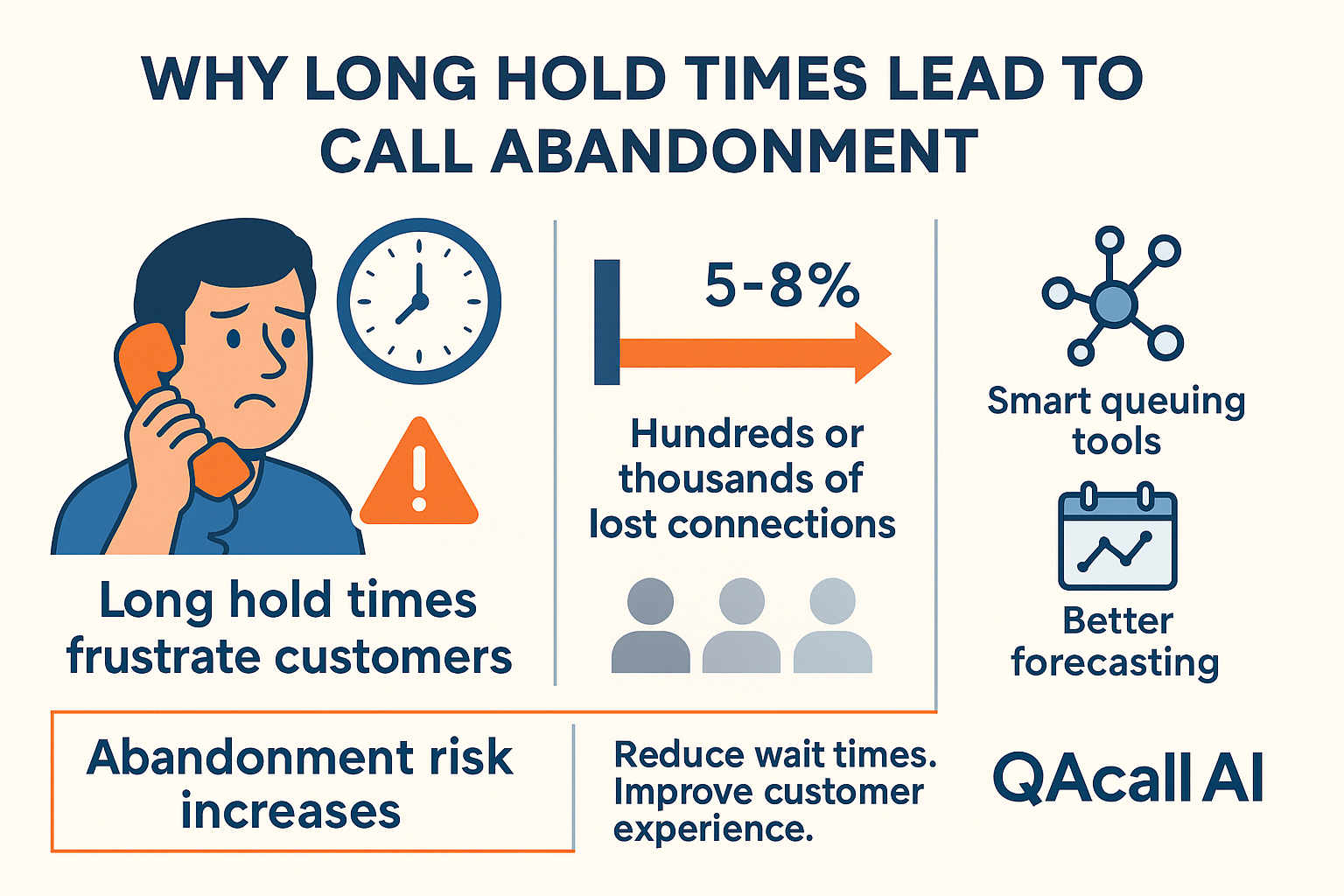
Nobody likes waiting. When call duration stretches too long before a caller connects with a human, it triggers frustration. In a world of instant everything, callers expect quick answers. If they’re stuck on hold for more than a few minutes, that’s a fast track to a call’s abandoned status.
Even going just slightly over the acceptable call abandonment rate (usually around 5-8%) could mean hundreds – or even thousands – of lost connections each month.
Solution: Smart queuing tools, better forecasting, and workforce management strategies can reduce wait times dramatically.
2. Poor Call Routing
Nothing makes a customer feel more invisible than being transferred three times just to answer a simple question. Inefficient call routing creates longer wait times, inconsistent service quality, and a big spike in center calls abandoned.
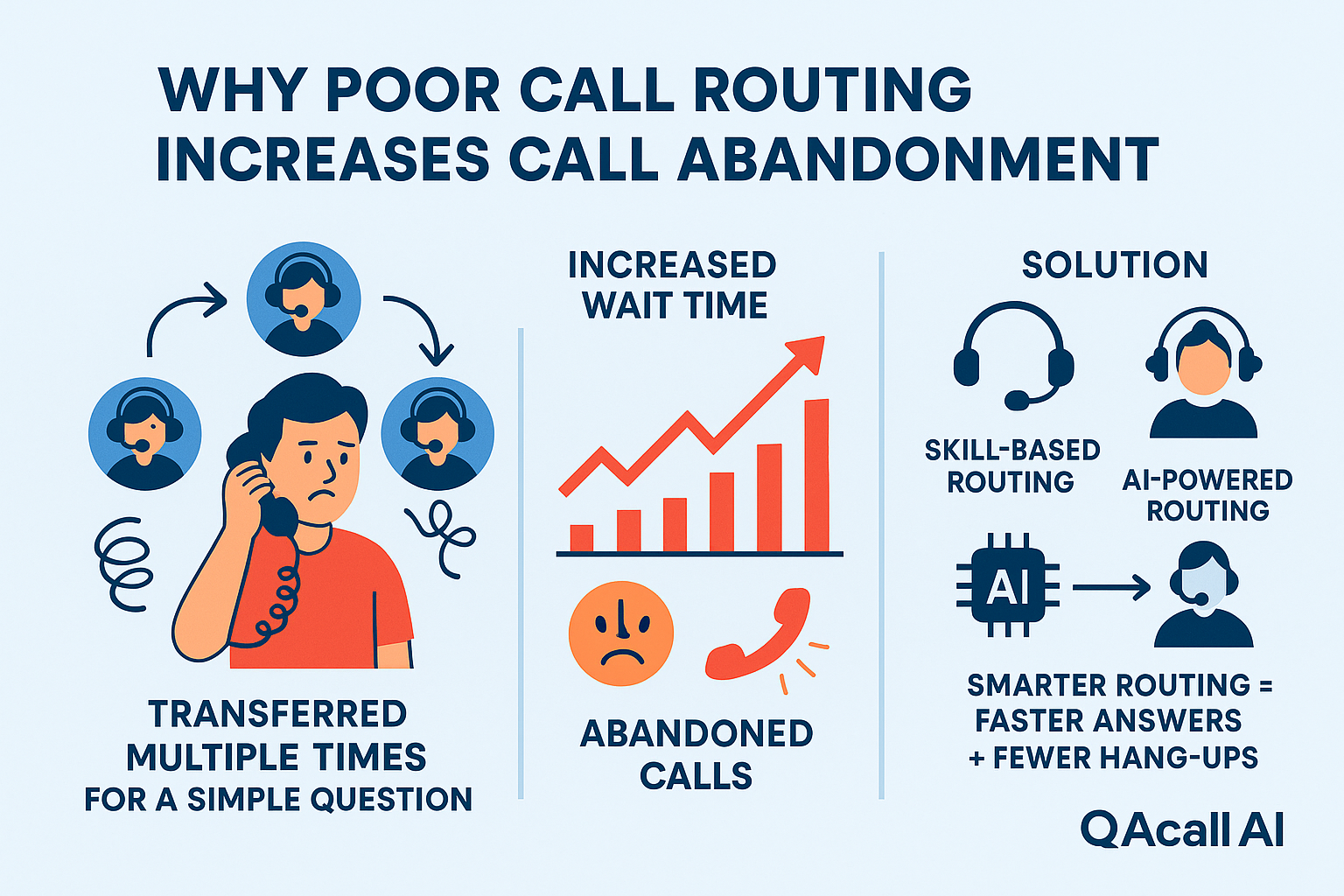
Solution: Skill-based and AI-powered routing helps connect callers to the right person faster, making your call center smoother and smarter.
3. Confusing IVR Trees
“Press 1 for this… press 2 for that…” We’ve all been there. Complicated IVR menus can drive customers up the wall, especially when they feel like they’re going in circles or can’t get through to a real person. It creates confusion, adds to the call duration, and makes hanging up feel like the only option.
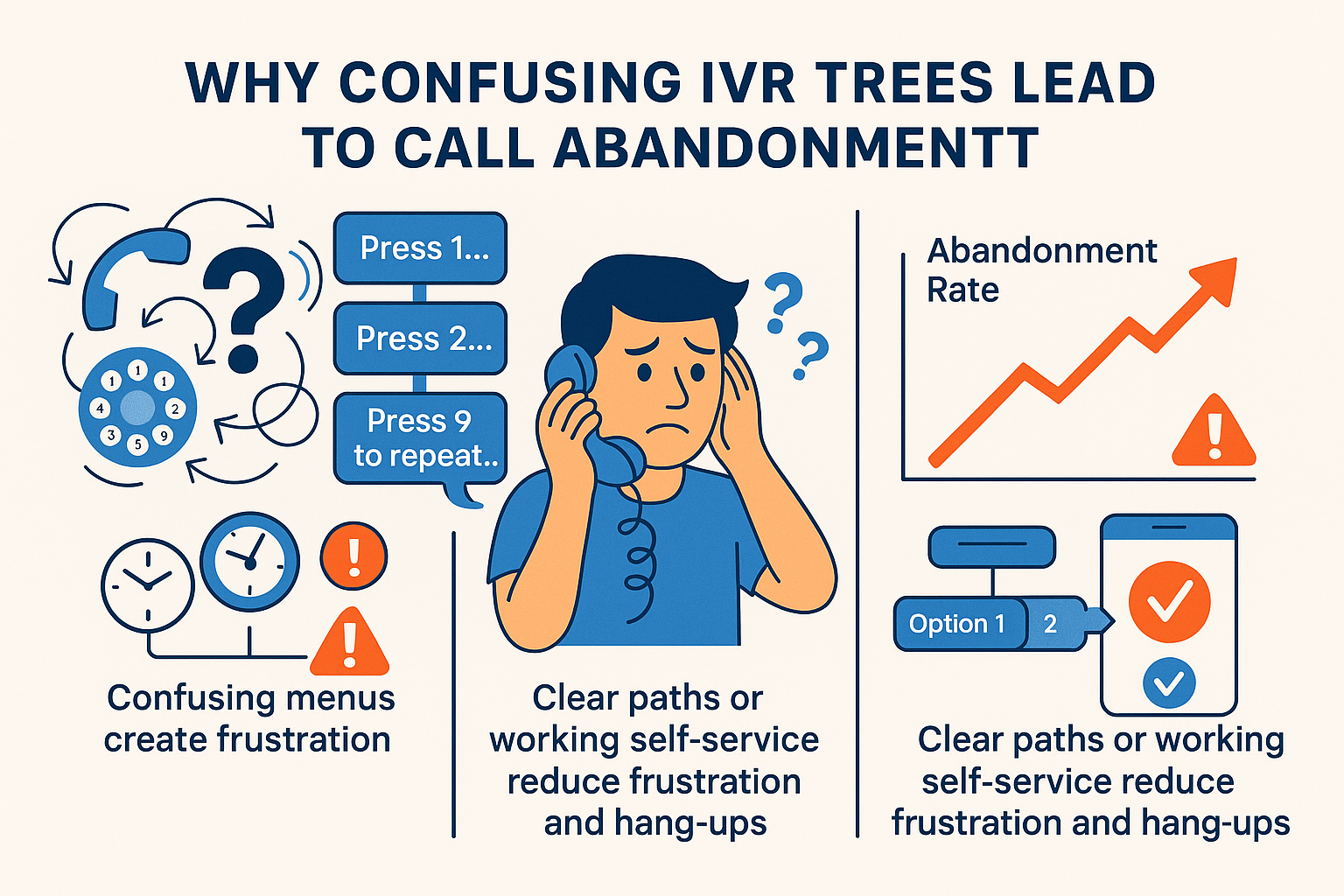
Solution: Simplify your IVR and give people a clear path to an agent, or provide self-service options that actually work.
4. No Call-Back Option
Time is precious. If a customer has to hang up due to other commitments, and there’s no option for a call-back, chances are you’ve just lost them. It turns what could’ve been a quick fix into yet another one of your calls abandoned.
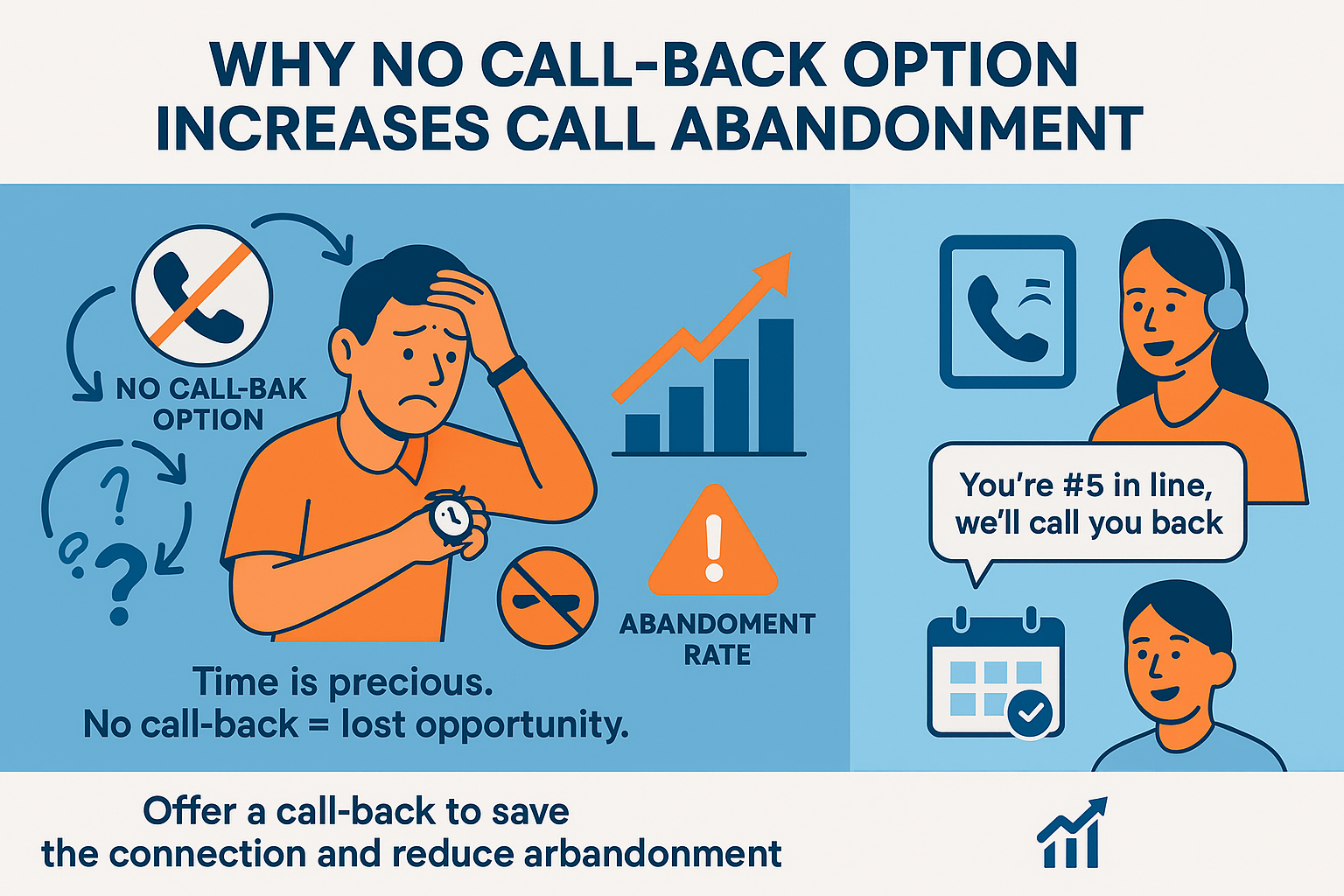
Solution: Let callers reserve their place in line with a call-back feature. It’s a small gesture that goes a long way in reducing your call abandonment rate.
5. Frustration from Poor Previous Support
Let’s be honest – if someone had a bad experience with your team last time, they’re coming into this new call with low expectations. And if the same issues show up again? Click. Another customer call, gone.
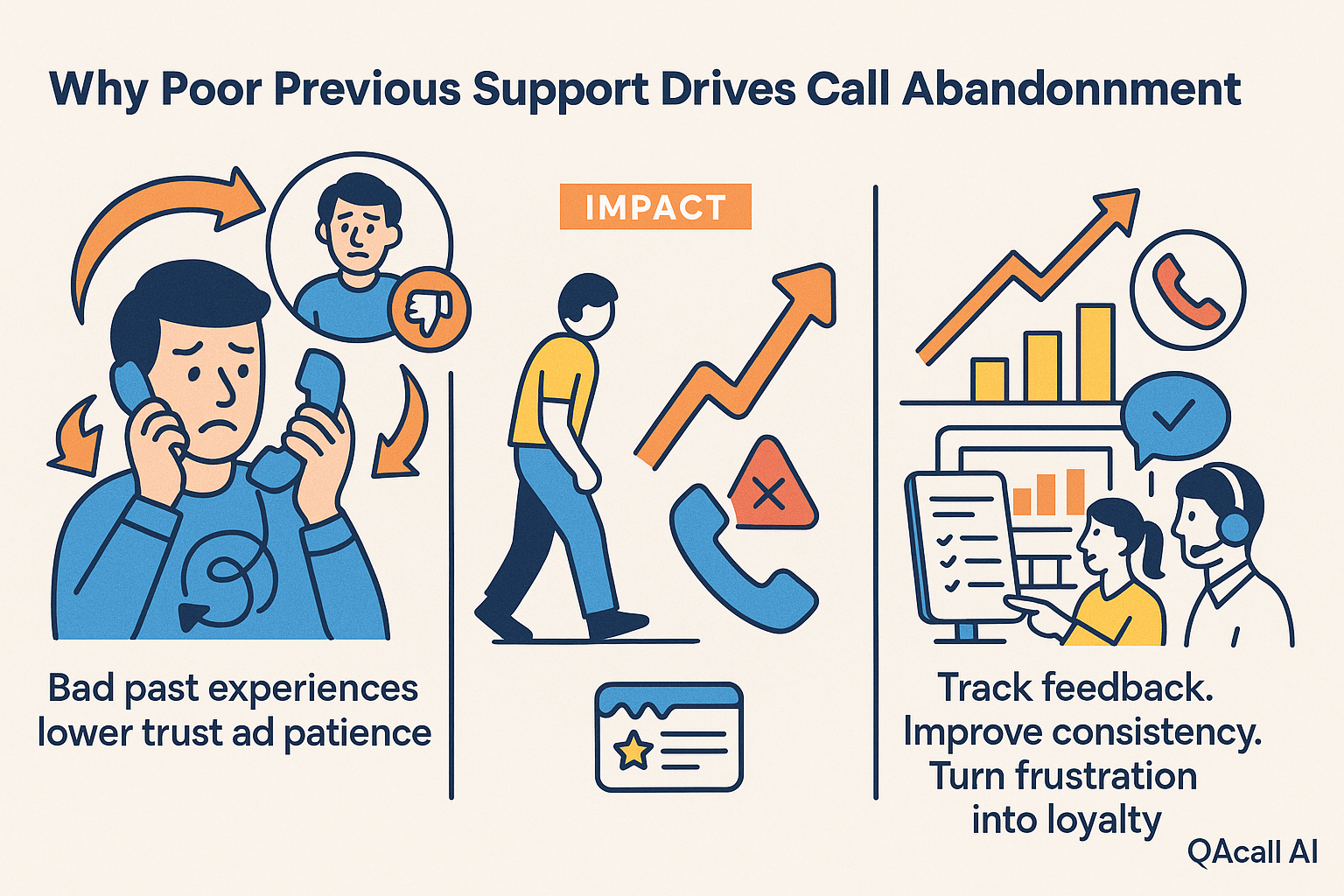
Solution: Use Customer feedback tools to track patterns and ensure consistent service quality improvement. Platforms like QAcall AI can help flag recurring issues and coach your agents in real time.
6. Technical Issues or Dropped Connections
Sometimes, the line cuts out, and sometimes, the app freezes. Whether it’s the customer’s connection or yours, these issues often result in calls abandoned without warning. While not always in your control, they still affect your call center abandonment rate and brand perception.
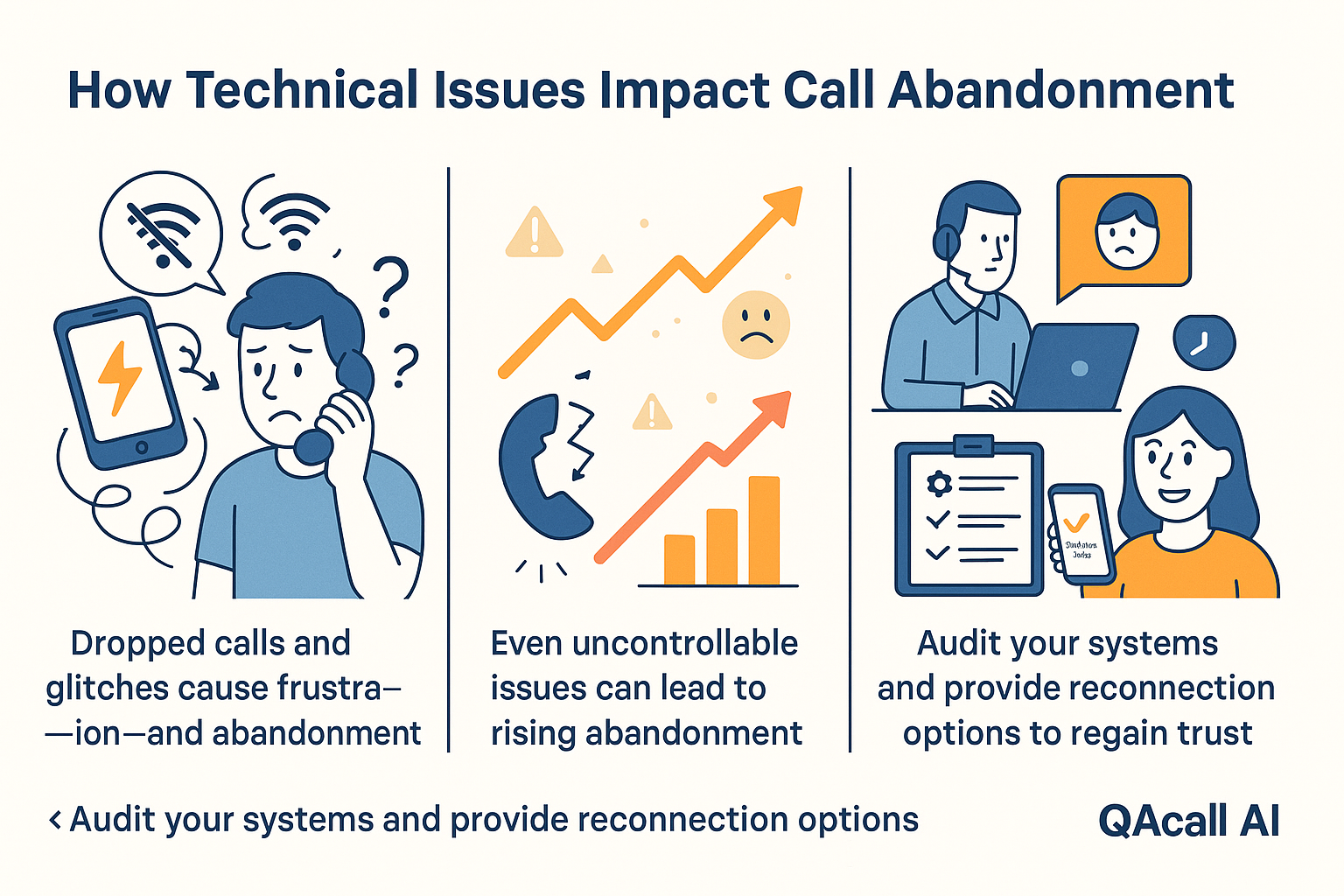
Solution: Regularly audit your systems and offer easy reconnection paths. A smooth experience builds trust, even when hiccups happen.
Reducing call abandonment isn’t about being perfect – it’s about knowing where the friction lives and addressing it head-on. When you understand what’s pushing customers away, you can start creating a support experience that keeps them engaged, supported, and willing to call again.
With tools like QAcall AI, better self-service options, and a tighter handle on routing and call center management, staying within that acceptable call abandonment rate becomes not just possible but expected.
Why Lowering Call Abandonment Rate Matters
Call abandonment might seem like just another metric in your dashboard… but it’s actually telling you something pretty important: how well your call center is showing up for customers when they need you most.
Whether it’s a wave of incoming calls or just a few busy hours, a lower call abandonment rate means smoother interactions, happier people, and a support system that actually works.
1. It Improves the Customer Experience and Loyalty
If someone picks up the phone to call your business, they’re already past the point of Googling – they want real answers. But if that incoming call ends in silence or endless hold music? That’s a fast track to frustration.
A high call abandonment rate shows customers aren’t getting what they came for, and that damages the customer experience badly. On the flip side, when calls are answered quickly and helpfully, people remember – and they come back.
2. It Saves You Real Money (and Sales)
Abandoned calls = missed opportunities. Here’s how it adds up:
| What Happens | What You Lose |
| A product question goes unanswered | A potential sale |
| A returning customer gives up mid-hold | Repeat business |
| A hot lead can’t reach a rep | Conversion momentum |
Your number of calls might be high, but it’s the answered ones that drive growth. Every dropped call is money left on the table.
3. It Keeps You Out of SLA Trouble
“If you promise fast support but callers keep hanging up, you’re not just disappointing them – you’re risking violations.”
In many industries, call centers have SLAs (Service Level Agreements) that set expectations for how quickly support should respond. If your call abandonment rate climbs too high and exceeds the center abandonment rate benchmark, you could face penalties or unhappy clients. No one wants that kind of pressure.
4. It Reveals Operational Red Flags
When your call abandonment rate creeps up, it’s often a red flag that something behind the scenes isn’t working. Common culprits:
- Not enough agents are scheduled during peak incoming calls
- Clunky IVR menus or slow routing, no self-service options to lighten the load
- Lack of visibility into real-time data.
Fixing these areas doesn’t just lower your abandonment rate – it boosts your entire call center’s performance.
5. It Builds (or Breaks) Brand Trust
You work hard to earn your customers’ trust – don’t lose it over something as fixable as call handling. A responsive call center builds confidence, and confidence builds loyalty. Here’s how it plays out:
| High Call Abandonment | Low Call Abandonment |
| Customers hang up before getting help | Calls are answered fast, and issues are resolved |
| Frustration, bad reviews, and lost loyalty | Better customer experience, stronger brand |
| Slipping NPS and CSAT scores | Happy customers who come back and refer others |
So yeah, lowering your call abandonment rate isn’t just about stats – it’s about creating an experience that feels reliable, respectful, and genuinely helpful. And with tools like QAcall AI in your corner, getting there isn’t just possible – it’s pretty simple.
How to Calculate Call Abandonment Rate
Alright, so how do you measure your call abandonment rate? The formula is simple, but you’ll want to watch for a few things if you want to calculate it accurately.
Here’s the standard formula used by most call centers:
(Calls Offered – Calls Handled) ÷ Calls Offered × 100
Let’s break it down:
- Calls Offered = the total number of incoming calls your system received.
- Calls Handled = the number of calls that successfully reached an agent and were answered.
- The difference between these two gives you the number of calls abandoned – the ones where the customer gave up before speaking to someone.
So, let’s say your call center received 1,000 calls in a day, and 850 of those were handled. That means 150 callers didn’t stick around long enough to get help. Plug it into the formula:

That means 15% of your customers bailed before getting assistance, which, depending on your industry’s center abandonment rate benchmark, is a big deal.
But wait – here are a few nuances that matter:
- Exclude super-short calls: Many businesses choose to ignore calls that were abandoned within 5 to 10 seconds. These might just be accidental dials or quick disconnects -not necessarily true indicators of a broken process.
- IVR vs. queue-level abandonment: Not all abandonments happen in the same place. Some callers hang up while stuck in the IVR menu (you know, “press 1 for billing”), while others wait in line for an agent and leave out of frustration. Knowing where they are abandoned gives you a better sense of what needs fixing.
- Watch for short calls and transfers: If a call is answered but ends within a few seconds, or gets transferred and then dropped, it might still reflect a poor customer experience. Make sure your analytics platform helps you see what’s really happening during those edge cases.
Bottom line? Calculating your call abandonment rate is about more than just plugging numbers into a formula. It’s about understanding the full story behind those calls abandoned – and using that insight to make real improvements.
What’s a Good Call Abandonment Rate? (Industry Benchmarks)
So, you’ve crunched the numbers and figured out your call abandonment rate – but what does that percentage actually mean?
Well, not all abandonments are created equal. Some level of hang-ups is normal, especially during peak hours or unexpected spikes in incoming calls. But when the number starts creeping up too high, it’s a clear sign something’s off in your call center flow or your customer experience overall.
General Targets to Aim For:
Here’s how most experts categorize abandonment rates:
| Abandonment Rate | What It Means |
| Less than 5% | Great! You’re right on track. |
| 5%–8% | Caution zone—monitor closely. |
| 10% or more | 🚨 Red flag! Time to take action. |
A call abandonment rate above 10% is usually a signal that customers are waiting too long, your system is overloaded, or something is breaking down during the interaction. It’s worth a deeper look – before those dropped calls start affecting revenue and satisfaction.
Call Abandonment Benchmarks by Industry
Different industries have different norms based on call types, urgency, and expectations. Here’s a quick snapshot of common center abandonment rate benchmark ranges:
| Industry | Benchmark Abandonment Rate |
| Retail | 5–8% |
| Healthcare | 4–6% |
| Finance | 3–5% |
| Telecom | 6–9% |
| Travel & Hospitality | 5–7% |
| Tech Support | 4–6% |
Keep in mind – these are just guidelines. A low-volume clinic might operate just fine with a 4% call abandonment rate, while a busy telecom center might hover around 7% and still deliver a great customer experience. It’s all about what makes sense for your business goals and caller expectations.
The key is not to chase perfection, but to stay within your industry’s healthy range and keep improving wherever you can. And yep, if you’re consistently above benchmark, tools like QAcall AI can help you troubleshoot exactly where and why customers are hanging up.
How to Monitor & Analyze Abandonment Rates
Once you know your call abandonment rate, the next step is staying on top of it – and that means more than just checking your weekly reports. The best call centers keep a close eye on abandonment trends in real time, while also digging into patterns over days, weeks, or months.
Here’s how to do it effectively:
Use Real-Time Dashboards and Historical Reports
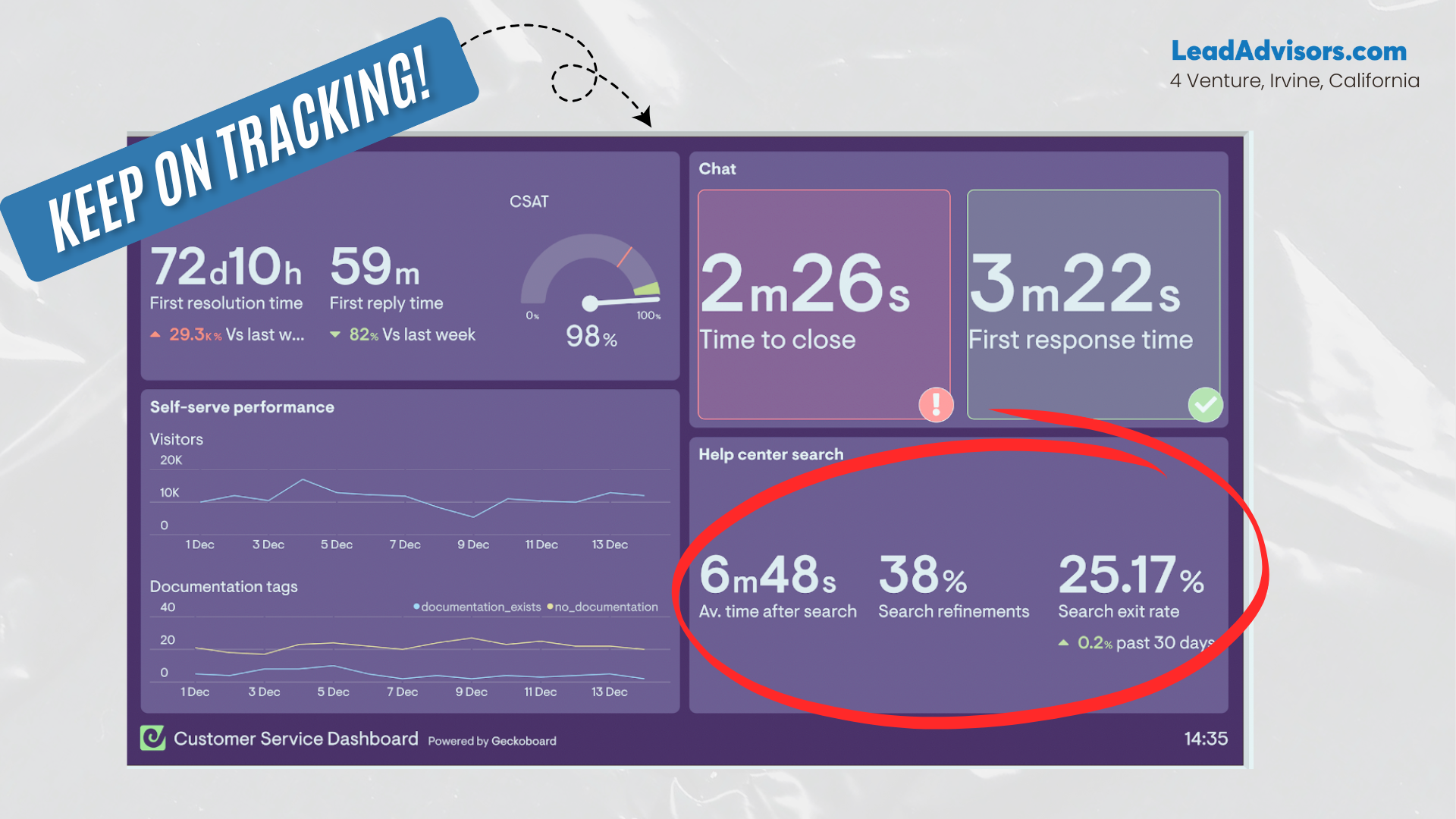 Real-time dashboards help you spot issues as they’re happening. If abandonment is spiking during a certain shift or campaign, you can adjust staffing, reroute calls, or activate self-service features right away. Meanwhile, historical reports help you understand long-term patterns and track progress against goals.
Real-time dashboards help you spot issues as they’re happening. If abandonment is spiking during a certain shift or campaign, you can adjust staffing, reroute calls, or activate self-service features right away. Meanwhile, historical reports help you understand long-term patterns and track progress against goals.
Segment Your Data for Better Insights
Looking at your abandonment rate as one big number won’t tell you much. To get to the “why,” you need to break it down into segments like:
- Time of Day – Are most calls abandoned in the afternoon or early morning? That could indicate staffing issues.
- Agent Group – Is one team getting more hang-ups than others? Maybe they need more support or different routing rules.
- Campaign – Certain marketing pushes might generate higher incoming calls. Are you ready for those spikes?
- Call Type – Are billing calls more likely to be dropped than technical support calls? This says something about customer frustration levels.
Track It Against Other Key Call Center Metrics
Your call abandonment rate doesn’t live in a vacuum – it’s tied to other metrics that reflect your customer experience and efficiency. To get the full picture, keep it side-by-side with KPIs like:
- Average handle time – Longer call handling could mean fewer available agents, leading to more people waiting… and abandoning.
- Queue Wait Time – Obvious but important: the longer people wait in line, the more likely they are to hang up.
- FCR (First Call Resolution) – If callers have to contact you multiple times, they’re more likely to give up altogether.
The more context you add, the clearer your action plan becomes. And with smart tools like QAcall AI, you can monitor all these metrics in one place, with alerts, trends, and even recommendations to fix issues before they get out of hand.
How QAcall AI Helps You Analyze Abandonment More Effectively
Monitoring is good. But turning insight into action? That’s where QAcall AI shines. Here’s how it helps you understand – and fix – what’s really causing call abandonment.
Real-Time Intelligence
Instead of waiting for end-of-day reports, QAcall AI monitors real-time sentiment, script adherence, and call scoring while calls are happening. For more ways AI is reshaping CX operations, see how artificial intelligence in the call center is helping teams anticipate problems before they start. If frustration spikes or an agent veers off script, you’ll know immediately, giving you the chance to prevent an abandoned call before it happens.
Instant Alerts When Calls Go Off-Track
No more guessing. You get proactive alerts when something isn’t right:
| Trigger | Response from QAcall AI |
| The customer shows signs of frustration | Real-time alert sent to supervisor |
| Agent deviates from the approved script | Call flagged for review or live coaching |
| High-risk keywords or hesitation | Predictive scoring updates immediately |
This lets your team act on issues during the call – not after it’s too late. It’s one of the smartest ways to implement call center quality assurance best practices without relying only on post-call analysis.
Pinpoint Where Customers Drop Off
Ever wonder exactly when someone hangs up in frustration? QAcall AI tells you. Whether it’s during hold, after a long IVR menu, or midway through an explanation, QAcall AI shows you the exact moments where customer experience begins to break down.
Predictive Analytics to Stay Ahead
QAcall AI goes beyond tracking. It uses predictive analytics and trend reports to anticipate when and why your call abandonment rate might spike, based on time of day, agent groups, call types, or campaign changes. You can finally spot patterns before they become problems.
Smarter Coaching and Manager Oversight
With clearer insights, managers can:
- Identify call center training gaps using call sentiment trends
- Coach agents on specific behaviors that lead to calls being abandoned
- Compare performance across teams or campaigns for more innovative staffing.
This gives supervisors the full story – not just metrics, but meaning behind the numbers.
In short? QAcall AI takes you from reactive to proactive. Instead of wondering why your call abandonment rate is high, you’ll have the tools to stop it from rising in the first place.
Predictive Forecasting: Abandon Curves & Erlang A Modeling

Let’s take a step into the future – literally. One of the best ways to reduce your call abandonment rate is to predict when and why people will hang up before they even do it. That’s where abandoned curves and Erlang A modeling come in.
These tools help you understand customer behavior at scale, forecast call flow, staff smarter, and keep more callers on the line.
What Is “Average Patience”?
Average Patience, also called Average Time to Abandon (ATA), is the amount of time a caller is willing to wait in the queue before hanging up. It’s a critical input when predicting abandonments.
Think of it this way: if your ATA is 72 seconds, and your queue wait time is averaging 90 seconds, you already know you’re losing callers. Knowing your ATA helps you design queues, schedules, and routing that respect customer tolerance and reduce abandoned calls.
How to Build Abandoned Curves
An abandonment curve is a visual representation that shows when callers typically drop off while waiting. Building one is easier than it sounds:
- Collect Data: Track timestamps of incoming calls and the exact time they were abandoned.
- Group by Time Intervals: Divide abandonments into time segments (e.g., 0–10 sec, 11–20 sec, etc.).
- Chart the Results: Plot those abandonments on a line graph to see when drop-offs peak.
This curve helps you understand how long most people are willing to wait and how that changes throughout the day. You can then tailor staffing, offer callbacks, or tighten up IVRs around those critical timeframes.
How Erlang A Helps You Predict Abandonment
Now let’s talk about Erlang A, the math model behind smarter call center forecasting.
| Model | Purpose |
| Erlang A | Predicts the impact of call volume, average patience, and agent availability on call abandonment rates |
Unlike Erlang C (which assumes no abandonments), Erlang A considers human behavior. It uses ATA, call volume, and agent staffing to model the percentage of callers who will likely hang up before getting help.
With Erlang A, you can:
- Forecast calls are abandoned during peak hours
- Test “what-if” staffing scenarios
- Decide when to offer call-backs vs. live queues.
- Optimize shift schedules based on real patient behavior.
Common Mistakes to Avoid When Measuring Call Abandonment

Tracking your call abandonment rate sounds simple, right? But if you’re not careful, a few common missteps can distort your data – and lead you to the wrong conclusions. Here’s how to avoid those traps and get more accurate insights from your numbers.
Only Tracking Post-IVR Drop-Offs
If you only consider abandonment after a customer enters the agent queue, you’re missing a big chunk of the story. Many callers hang up during the IVR stage, especially if the menu is too long, confusing, or doesn’t offer a clear “talk to someone” option.
Tip: Track both IVR-level and queue-level abandonments separately. That way, you’ll know where the real friction is happening.
Double-Counting Transferred Calls
When a customer is transferred between departments or agents, it’s easy for that call to be logged twice – once as handled, and again as abandoned if the transfer goes sideways.
Why it matters: This inflates your call abandonment rate and makes your agent metrics look worse than they are.
What to do: Use a system that tracks the full journey of each unique call, even when it bounces around internally.
Excluding Short Abandons Without a Second Thought
Some call centers automatically exclude calls abandoned in under 5 or 10 seconds, assuming they’re misdials or spam. But sometimes those are real customers who bailed quickly because of a long greeting, slow connection, or an IVR delay.
Pro move: Don’t filter them out without reviewing what the customer heard during those first few seconds. The problem might be hiding right at the start.
Ignoring IVR-Level Drop-Outs
Just because a customer didn’t wait in the queue doesn’t mean the experience was smooth. If someone hangs up before ever reaching an agent, that’s still a failure in the customer experience, especially if your IVR is clunky or missing helpful options.
Fix it by: Simplifying your menu, providing clear “talk to a human” shortcuts, and monitoring where customers drop out during automated flows.
Not Linking Abandonment to Other KPIs
A spike in abandonment isn’t always about long wait times. It could be connected to your AHT (Average Handle Time), low FCR (First Call Resolution), or poor CSAT scores. If you’re only looking at abandonment in isolation, you’re missing the bigger picture.
Smart strategy: Layer your data. Compare abandonment trends with queue wait times, agent behavior, and sentiment scores to see what’s really going on – and fix it faster.
Getting your call abandonment tracking right means fewer surprises, better coaching opportunities, and a more accurate picture of your call center’s performance.
FAQs About Call Abandonment Rate
1. How does call abandonment impact customer satisfaction scores (CSAT)?
2. What role does agent occupancy rate play in call abandonment?
3. Can abandoned calls ever be considered “successful” interactions?
4. How often should you review and update your IVR menus to reduce abandonment?
5. Are there seasonal patterns in call abandonment rates?
Make Every Call Count
Your call abandonment rate isn’t just a stat – it’s a signal. Every dropped call represents a lost chance to help, sell, or build trust.
But here’s the good news: it’s fixable.
With the right strategies – like smarter routing, callbacks, better IVRs, and real-time agent support – you can reduce abandonments and deliver a better customer experience. Tools like QAcall.AI make it even easier by giving you live insights, sentiment tracking, and performance coaching that actually work.
The goal isn’t just fewer hang-ups. It’s happier customers.

